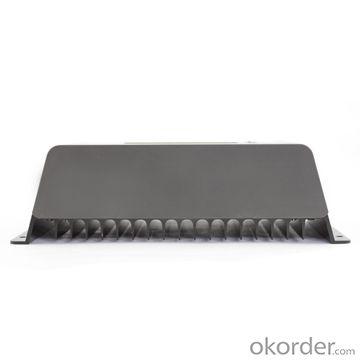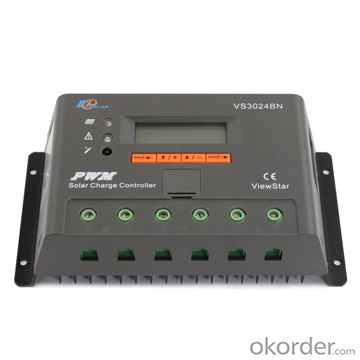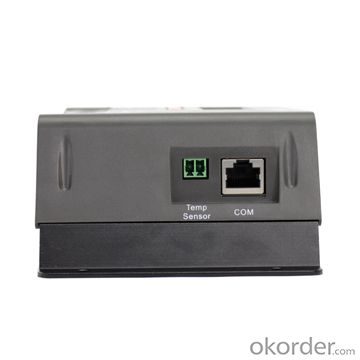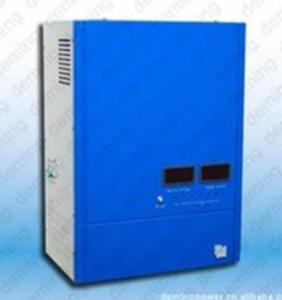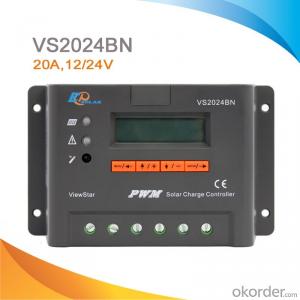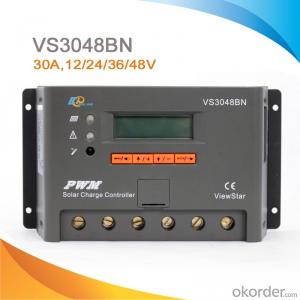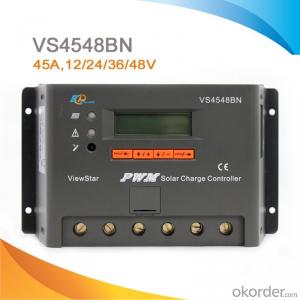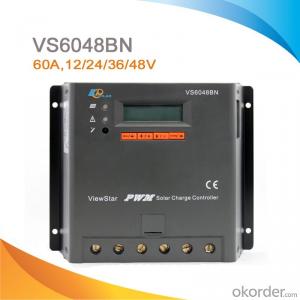Rv Solar Controllers - LCD/LED High Quality PWM Solar Panel Charge Controller/Regulator with CE ROHS, 30A 12V/24V, VS3024BN
OKorder Service Pledge
OKorder Financial Service
You Might Also Like
Features:
·Excellent EMC design
·32 bit MCU with high speed
·High efficient Series PWM charging
·Four battery type options: Sealed, Gel, Flooded, and USER
·Intelligent lighting and timer control for solar lighting system
·12 bit A/D high-precision sampling to ensure accuracy
·Use MOSFET as electronic switch
·Full control parameters setting and modification, diversified load control mode
·Humanized design of browser interface, undertake every operating conveniently
·Temperature compensation
·Adopt graphics dot-matrix LCD screen and HMI (human-machine interface) with 4 buttons,integrated menu displaying and operation
·Energy statistics function
·RS485 ports with MODBUS communication protocol
·Optional PC monitoring software and remote meter for real-time monitoring and battery management parameter setting
·Field upgradable firmware
Electronic Protections:
·PV short circuit protection
·PV reverse polarity protection
·Battery overcharge protection
·Battery over discharge protection
·Battery reverse polarity protection
·Load overload protection
·Load short circuit protection
·Overheating protection
Specification:
Model | VS1024BN | VS2024BN | VS3024BN | VS4524BN | VS6024BN |
Nominal system voltage | 12V/24V auto work | ||||
Rated battery current | 10A | 20A | 30A | 45A | 60A |
Rated load current | 10A | 20A | 30A | 45A | 60A |
Max. battery voltage | 32V | ||||
Equalize charging voltage | Sealed: 14.6V, Flooded: 14.8V, User-defined: 9~17V | ||||
Boost charging voltage | Gel: 14.2V, Sealed: 14.6V, Flooded: 14.8V, User-defined: 9~17V | ||||
Float charging voltage | Gel /Sealed /Flooded: 13.8V, User-defined: 9~17V | ||||
Low voltage reconnect voltage | Gel /Sealed /Flooded: 12.6V, User-defined: 9~17V | ||||
Low voltage disconnect voltage | Gel /Sealed /Flooded: 11.1V, User-defined: 9~17V | ||||
Self-consumption | ≤15mA(12V); ≤10mA(24V); ≤9mA(36V); ≤8mA(48V) | ||||
Grounding | Common negative | ||||
Temp. compensation | -3mV/°C/2V | ||||
Relative humidity | 10%~90% Non-condensation | ||||
Communication | RS485 / RJ45 interface | ||||
LCD temperature | -20°C ~ +70°C | ||||
Working temperature | -25°C ~ +55°C | ||||
Humidity | ≤95% N.C. | ||||
Enclosure | IP30 | ||||
Overall dimension | 162x85x40mm | 162x100x50mm | 200x103x58mm | 201x109x59mm | 205x129x67mm |
Terminals | 4mm2 | 10mm2 | 16mm2 | 35mm2 | 35mm2 |
Net weight | 0.2kg | 0.4kg | 0.7kg | 0.9kg | 1.3kg |
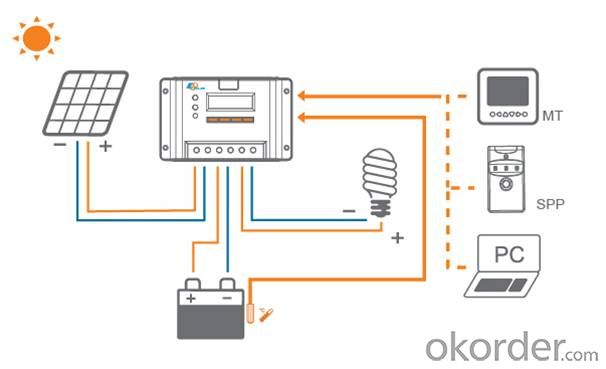
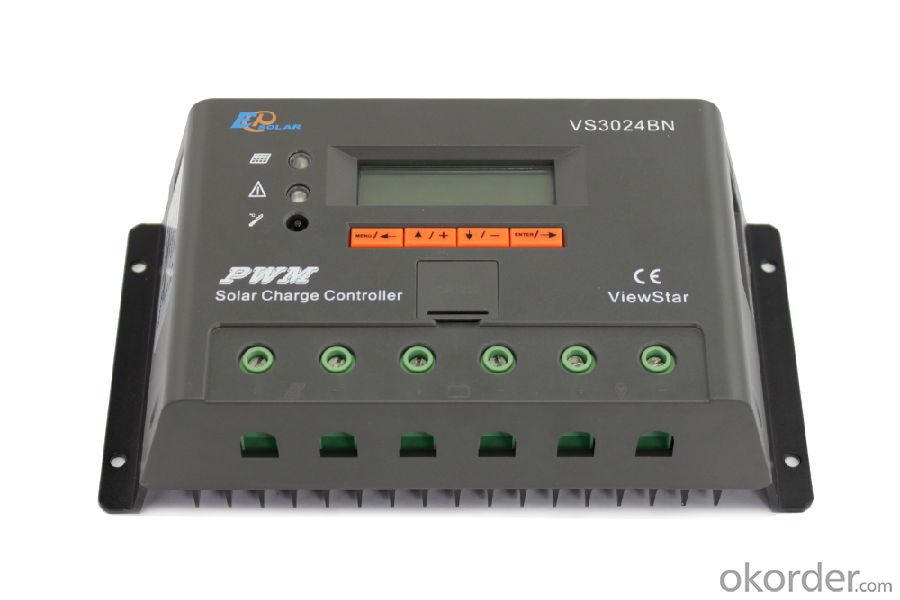
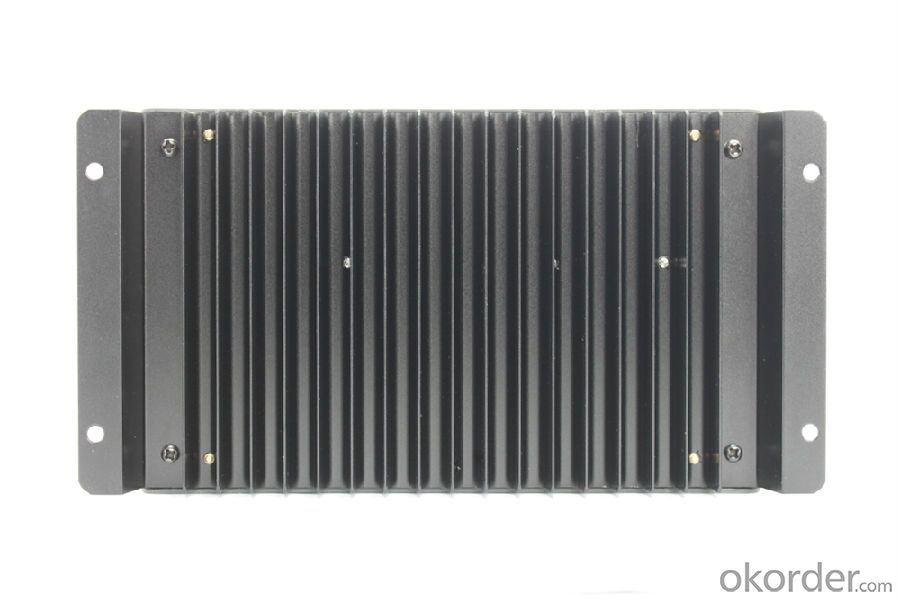


FAQ:
Q1. What is the voltage?
A1. Our 45/60A solar charge controller is 12/24/36/48V auto work.
Q2. What is the difference between MPPT&PWM?
A2. MPPT has higher efficiency, it can track the max power point and won't waste energy.
Q3. What is the efficiency of the MPPT controller?
A3. MPPT>99%, peak conversion efficiency>98%.
Q4. What is the waranty of product?
A4. 12 months.
Q5. What protection does your MPPT controller have?
A5. PV array short circuit, PV reverse polarity, Battery reverse polarity, Over charging, Output short circuit
- Q: How does a solar controller handle battery capacity testing?
- A solar controller handles battery capacity testing by monitoring the voltage and current of the battery during the charging and discharging process. It uses this data to calculate the state of charge (SOC) of the battery, which indicates the remaining capacity. The solar controller may also use algorithms to estimate the battery capacity based on its performance over time.
- Q: How do you determine the optimal charging voltage for your batteries using a solar controller?
- To determine the optimal charging voltage for batteries using a solar controller, one needs to consider the battery type and manufacturer's recommendations. The solar controller should be programmed or set according to these specifications to ensure the batteries are charged efficiently and safely. Additionally, monitoring the battery voltage during charging and adjusting the controller settings accordingly can help optimize the charging process.
- Q: How do I install a solar controller in my solar panel system?
- The process of installing a solar controller in your solar panel system is quite straightforward. Allow me to guide you through the steps: 1. Determine an appropriate location: Find a suitable spot near your solar panels where you can mount the solar controller. It should be shielded from direct sunlight, rain, and extreme temperatures. 2. Gather the required tools: You'll need a screwdriver, wire strippers, electrical tape, and mounting brackets (if not provided with the solar controller). 3. Disconnect the solar panels: Prior to commencing the installation, disconnect the solar panels from the battery and charge controller, if already installed. 4. Mount the solar controller: Attach the mounting brackets to the solar controller, and then fasten the brackets to a suitable surface close to the solar panels. Ensure easy accessibility for future maintenance. 5. Connect the battery: Identify the battery terminals on the solar controller, and connect the positive (+) and negative (-) leads from the battery. Remember to observe proper polarity to prevent damage. 6. Connect the solar panels: Locate the solar panel terminals on the controller, and connect the positive (+) and negative (-) leads from the solar panels. Again, ensure correct polarity to avoid any issues. 7. Secure the connections: Use wire strippers to remove a small section of insulation from the wire ends. Insert the stripped wires into the appropriate terminals on the solar controller, and tighten the screws to secure the connections. Ensure all connections are firmly secured. 8. Check the connections: Once all connections are made, double-check that everything is properly connected and tightened. Inspect for any frayed or damaged wires, and repair or replace them as needed. 9. Test the system: Reconnect the solar panels to the charge controller and battery. Turn on the solar panel system, and monitor the solar controller to ensure it functions correctly. Check for any error or warning messages, and troubleshoot accordingly. 10. Perform regular maintenance: Following installation, regularly inspect the solar controller for any issues, clean the solar panels, and inspect the wiring connections. This will help ensure optimal performance and extend the lifespan of your solar panel system. Remember, if you are uncertain about any step or lack the necessary electrical knowledge, it is advisable to seek assistance from a professional electrician or solar installer.
- Q: Can a solar controller be used with a solar-powered industrial facility?
- Yes, a solar controller can be used with a solar-powered industrial facility. A solar controller is an essential component of a solar power system as it regulates the flow of electricity from the solar panels to the facility's equipment, ensuring efficient energy usage and preventing overcharging or damage to the batteries. It helps optimize the power generation and distribution process, making it suitable for use in large-scale industrial applications such as factories, warehouses, or manufacturing plants.
- Q: Can a solar controller be used in off-grid solar systems?
- Yes, a solar controller can be used in off-grid solar systems. A solar controller is an essential component in off-grid solar systems as it regulates the charge and discharge of batteries, ensuring optimal performance and protection.
- Q: What is the maximum discharge efficiency of a solar controller?
- The maximum discharge efficiency of a solar controller refers to the percentage of energy released from the battery that is effectively utilized by the connected loads. It can vary depending on the specific solar controller model and its design, but generally, high-quality solar controllers can achieve discharge efficiencies of around 95% or even higher.
- Q: Can a solar controller be used with a generator or grid power as a backup?
- Yes, a solar controller can be used with a generator or grid power as a backup. A solar controller is designed to regulate the flow of electricity from the solar panels to the batteries or the power grid. When the solar panels are generating excess electricity, the solar controller can divert that energy to charge the batteries or feed it back into the grid. In the event that the solar panels are not generating enough electricity, such as during cloudy days or at night, a generator or grid power can be used as a backup source of electricity. The solar controller can seamlessly switch between the solar panels and the backup power source, ensuring a continuous supply of electricity to the system. This allows for greater flexibility and reliability in powering devices or appliances in off-grid or grid-tied solar systems.
- Q: Are all solar controllers compatible with all types of batteries?
- Not all types of batteries are compatible with all solar controllers. Solar controllers have the purpose of regulating the charging and discharging of batteries in a solar power system. Different batteries have varying voltage and charging requirements, which means that solar controllers must be matched with the specific battery being used. Solar power systems commonly use lead-acid, lithium-ion, and gel batteries. Each of these batteries has its own charging and discharging voltage range, as well as requirements for temperature compensation and equalization. Therefore, solar controllers need to be specifically designed to cater to these different types of batteries. For instance, a solar controller designed for lead-acid batteries may have different charging algorithms and voltage settings compared to one designed for lithium-ion batteries. Using an incompatible solar controller with a battery can result in inefficient charging, reduced battery lifespan, and potentially damaging the battery. To ensure compatibility, it is crucial to carefully review the specifications and recommendations provided by the solar controller manufacturer. These specifications typically outline the compatible battery types, voltage ranges, and other important details. If there are any doubts about compatibility between a solar controller and a specific battery, it is advisable to consult with a professional or contact the manufacturer for guidance.
- Q: Can a solar controller be used with solar-powered indoor irrigation systems?
- Solar-powered indoor irrigation systems can benefit from the use of a solar controller. The primary function of a solar controller is to regulate and optimize solar power generated by solar panels. With the solar controller connected to both the solar panels and the irrigation system, it can effectively control and manage the power supply to ensure efficient operation. Additionally, the solar controller has the capability to monitor energy production, track battery charging (if applicable), and automatically adjust power output to meet the irrigation system's requirements. This feature maximizes performance and guarantees smooth operation, even in indoor environments.
- Q: Can a solar controller be used with a solar-powered museum or gallery?
- Yes, a solar controller can definitely be used with a solar-powered museum or gallery. A solar controller is an essential component of a solar power system as it regulates the flow of electricity between the solar panels and the battery storage, ensuring optimum charging and preventing overcharging or damage to the batteries. In a solar-powered museum or gallery, where energy efficiency and sustainability are key, a solar controller would effectively manage the power generated by the solar panels, ensuring reliable and efficient operation of the facility's electrical systems.
Send your message to us
Rv Solar Controllers - LCD/LED High Quality PWM Solar Panel Charge Controller/Regulator with CE ROHS, 30A 12V/24V, VS3024BN
OKorder Service Pledge
OKorder Financial Service
Similar products
Hot products
Hot Searches
Related keywords





